(This is a picture heavy review and it may take a little
time to download if you don't have DSL. There is a book and contest for this line; scroll down to the
end.)
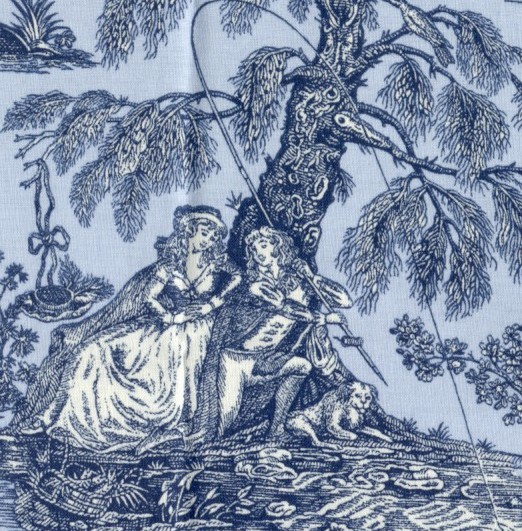
Ooh La La! This new line includes three scenic toiles, a medallion toile
border print, an overall medium scale flower and stem toile and one
small scale coordinating print of leaf shapes.
Toile prints are prevalent in the
US fabric markets in recent
years. There are those made for quilters (aren't we all glad about
that), with some based upon actual toiles prints. Often the size would be
smaller or the design detail might be simplified and they came only in
dark on light colorways as the originals ones would have been made. Non-traditional colorways, available later in fabric history, we have seen
reproduced in furnishing
fabrics. This new line combines good reproductions of actual toiles with furnishing
fabrics colorways. Traditionally toiles had white or crème grounds of
linen, cotton or fustian, printed with madder dye. Depending on the
mordant used, madder produced sepia (brown), red, and purple toiles.
Madder could make black too, but this was rarely done in a toile. Green was a two step process and was not likely to be made into a toile,
yet I own a green on white floral toile from 1825, so it was done, but
rarely. In places the yellow has faded and the print appears more blue, which
was probably Prussian blue, not indigo (Brackman, 2004) Blue toiles did
exists, but indigo was the ground color and lines were white.
By 1797 cotton became fashionable for bedrooms because of the
"antique" look toiles and other classical design could bring to
cotton via print, which could not be achieved through weaving of silk. (Laure
Hug, Antiques Mag., August 2002) Oberkampf and Huet took notice of this
and began to design their plates and rollers accordingly.
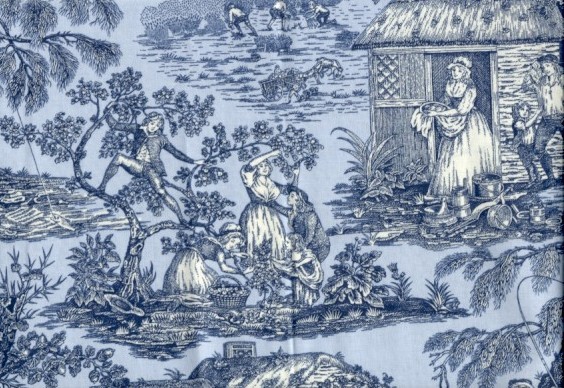
The
first toile is reproduced from The Four Seasons. The original
manufacturer is unknown but it was made in England after 1793 and based
upon English paintings. Although similar in title, this is not the toile
designed by Huet for Oberkampf's factory in 1785 called Les Quatres
Saisons or The Delights of the Four Seasons. This spring and summer
season toile design was adapted from Charles Catton II's painting by the
same name. He got his inspiration from a popular poem written by James
Thomson titled The Seasons. This Scottish poem influenced many English
and French designer's work in the mid- 18th century.
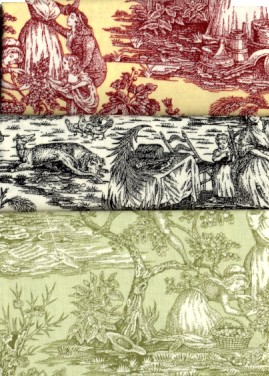
The Four Seasons
is printed in 4 colorways: red on pale
yellow, navy on light blue, medium yellow-green on a pale celadon green,
and black on white. White is used as a third color in each of the first
three colorways. This is an overall print, with no empty regions. The
scenes glide into each other. The people are fishing, washing and working
on the farm, picking berries, and sitting as a family. The repeat is about
13.5". Roller printed toiles of the day would have repeats about
15". Copperplate prints would produce larger repeats, 20" to
36" up to 36" square..
This next toile was reproduced from an early Huet design at Oberkampf's
factory, Jeu d'enfants or Children's Games. It was
adapted from an English design. The English led the design front in the
textile industry from approximately 1750-1785. After Oberkampf hired Huet in 1783, his toiles became more sought after and recognized as
the finest.
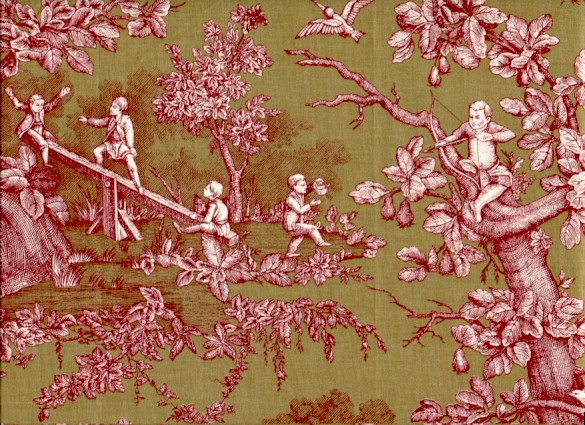
Children's Games
is printed as a reverse toile in five
colorways. In three, white figures are on a black, navy, or red
background. The other two have green grounds, one is an olive green with
white and dark red figures, and the other is a more yellow green with darker green and white figures. The children are playing
on see-saws, in trees, with bows and arrows, and riding dogs as if in a
race with a lady in a single-seat carriage also led by a dog. The repeat
is about 13.5". This toile is less dense than the first one,
probably because the scenes of of varying sizes. The backgrounds on all of
these prints are not mottled or patterned, but solid as they would have
been made then.
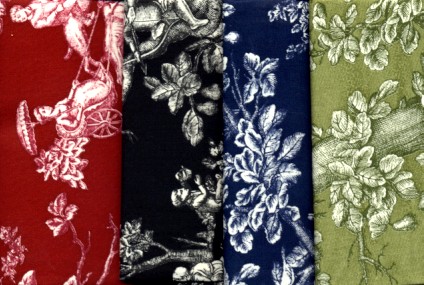
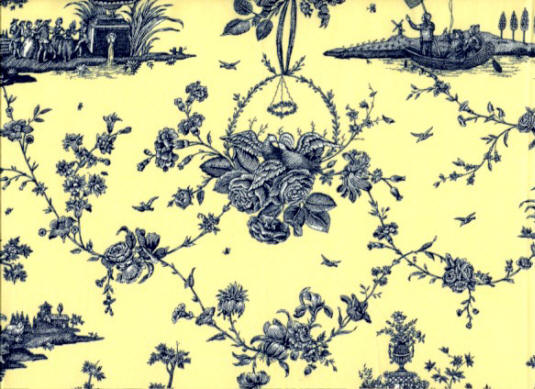
The third scenic toile is more delicate and the
least dense of the three scenic toiles. It features a winding and
cascading floral vines with stems and roses and carnations, separating the
scenic images. The stems meet at a bouquet with love birds perched
on it, and birds are flying about. The scenes are of various sizes and
show people enjoying leisure life activities. The variety of images and
sizes make this a compelling toile.
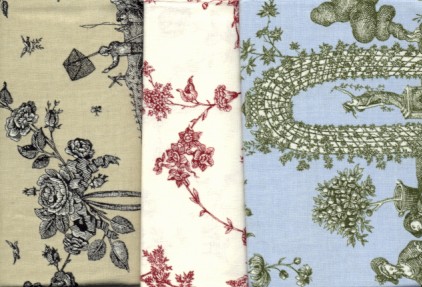
Le Jardin d'Amour, The Garden of Love
is
original source for this toile. The manufacturer is unknown and it was
made in Nantes, France, circa 1790.
It comes in four colorways: gray on light blue,
indigo on pale yellow, black on crème, and red on white. White highlights
are also on the first three prints.
When the neoclassical theme began to predominate
decorative arts, it coincided well with the burgeoning roller printing
process for fabric. The next print is a medallion border print, c. 1795,
made in France. Six borders per yard's width. The narrow strip dividing
them is also the design on the coordinating print that comes with this
collection. There are three different medallions inside the stripes, each
with a wreath of leaves around them. An additional style of print strip
borders the print, which can be used separately as an inner border or
sashing.
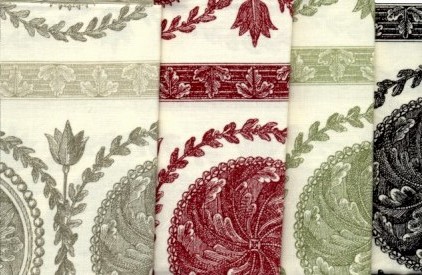
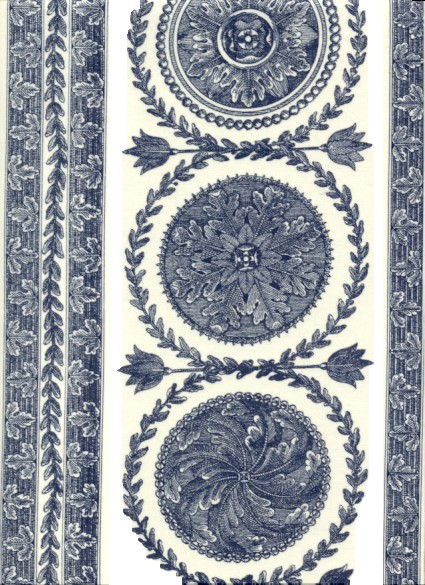
The coordinating print comes in 5 colorways of
a
white
leaf print on medium blue, black, gray-green, red & celadon.
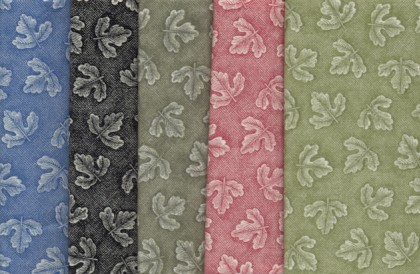
The last print in this group is a small to medium
size monochrome floral, with tossed flowers of different shapes and sizes
interspersed between tiny butterflies and birds.
These prints coordinate well with all the other prints in the group. They
are delicate and unique to the reproduction fabrics available today. This
is also a stand alone fabric for many types of quilts. Very nice!
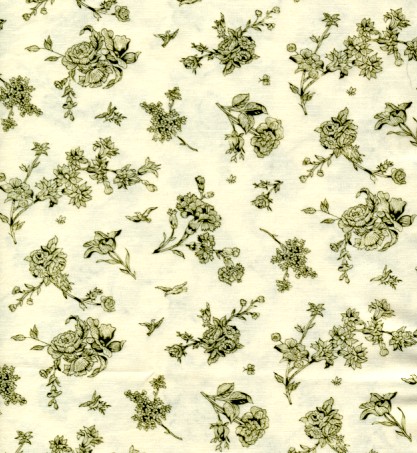
There are six colorways with three of them on
white grounds; red, black, and medium. The other colors have white
highlights with nay on medium blue, black on crème and red on olive
green.
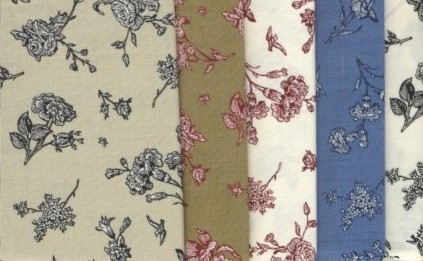
The
Museum is having a Quilt Challenge using 100% of this line. The entry deadline
is May 13, 2005. For guidelines, form and prizes go to:
http://www.allentownartmuseum.org/gallery/exhibits/quilt_prospectus.pdf
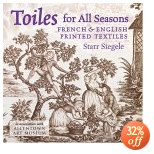
A new book based on the current exhibition of
toiles at the Allentown Art Museum, by Starr Siegele, the adjunct curator
of prints, is titled
"Toiles for all Seasons: French & English
Printed Textiles,"
Bunker Hill Publishing, 2004, the museum's
press. I have not seen it, so I can't comment, but it is
available through Amazon.com.
The exhibit ran through February 27, 2005.
|